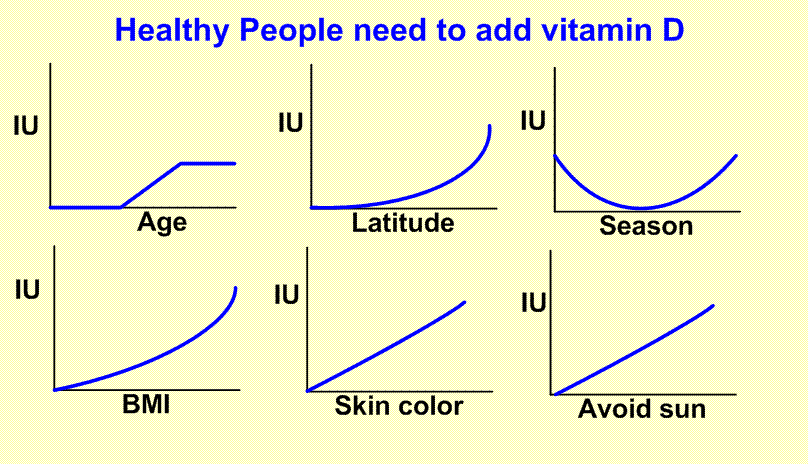1700 IU vitamin D (50000 monthly) helped antarctic explorers – RCT
Skeletal and hormonal responses to vitamin D supplementation during sunlight deprivation in Antarctic expeditioners.
Osteoporos Int. 2012 Jan 4.
Iuliano-Burns S, Ayton J, Hillam S, Jones G, King K, Macleod S, Seeman E.
Austin Health, University of Melbourne, Parkville, Australia, [email protected].
Sunlight deprivation results in vitamin D deficiency but serum vitamin D levels can be maintained above 50nmol/L when supplemented with 50,000IU at least every alternate month.
INTRODUCTION: Antarctic expeditioners are exposed to prolonged sunlight deprivation resulting in vitamin D deficiency.
We hypothesised that monthly dosing of 50,000 IU vitamin D (~1,600 IU daily) will increase serum 25-hydroxyvitamin D (25(OH)D), suppress parathyroid hormone (PTH) and improve bone mineral density (BMD), 50,000 IU alternate months (~800 IU daily) will maintain these measures, while a single 50,000 IU dose pre-departure (~1,00 IU daily) {137 IU daily} will not be protective.
METHODS: This was a randomised double-blind study involving 110 healthy adults: 91 males, mean age 41 years (range 24-65 years) working in Antarctica for up to 12 months, who we administered 50,000 IU vitamin D3 monthly, alternate months or a single dose pre-departure. Serum 25(OH)D, PTH, osteocalcin, CTx and calcium were assessed at baseline, mid- and end of expedition. Proximal femur and lumbar spine BMD were assessed pre- and post-expedition.
RESULTS: Baseline 25(OH)D was 59?±?14 nmol/L. By mid-expedition, 25(OH)D increased by 7 nmol/L in those supplemented monthly (p?50 nmol/L at baseline, 25(OH)D was maintained above this level with all regimens.
If 25(OH)D was <50 nmol/L at baseline, monthly or alternate month regimens were needed to achieve levels >50 nmol/L, the single pre-departure dose was ineffective.
CONCLUSION: During sunlight deprivation of up to 12 months, serum 25(OH)D levels can be maintained above 50 nmol/L when expeditioners are provided with 50,000 I U at least every alternate month.
PMID: 22215183
PDF, which was available to the public Dec 2012, is attached at the bottom of this page
Fig. 1
Time course of changes to 25(OH)D in expeditioners with serum 25(OH)D levels above (left panels) or below
(right panels) 50 nmol/L at baseline, and then treated with 50,000 IU monthly
23.6 ng baseline ==> 26.4 ng for monthly 50,000 IU of vitamin D (1,600 daily)
No change if just get bimonthly 50,000 IU of vitamin D (800 daily)
Vitamin D Life suspects that very few of the participants were overweight or pregnant
This should apply not only to those living very far from the equator, but also to those who get very little sun
See also Vitamin D Life
40 ng Vitamin D perhaps optimal for reduced mortality – Meta-analysis Jan 2012 26 ng is not enough
1600 IU daily Vitamin D raised adult blood levels above 20 ng – RCT Nov 2011 agrees with this paper
2000 IU of vitamin D is a step in the right direction for Canada– Nov 2010
Four reasons why vitamin D levels should be higher the 30 ng – Aug 2011
Cadavers with good skeletons had 30 ng of vitamin D – Feb 2010
Half of the seniors needed more than 50,000 IU vitamin D3 monthly – April 2011
Recommend 2500-4000 IU per day to reduce all-cause mortality by 18%– Grant Netherlands April 2010
How you might double the benefit of your vitamin D
- Such as the form of the supplement, the fats you take with it, essential co-factors, etc
People with no UV for 6 months in the winter need at least 2000 IU of vitamin D – April 2011 another Antarctic research paper
Overview How Much vitamin D need >2,000 IU if in a high risk group: has the following graph

